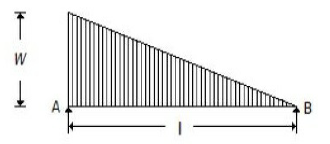For the beam shown in the below figure, the shear force diagram between A and B is

A horizontal line
A vertical line
An inclined line
A parabolic curve
Correct Answer :
D. A parabolic curve
Related Questions
A beam which is fixed at one end and free at the other is called
Simply supported beam
Fixed beam
Overhanging beam
Cantilever beam
The absolute zero temperature is taken as
-273°C
73°C
237°C
-237°C
The ratio of specific heat at constant pressure (cp) and specific heat at constant volume (cv) is always __________ one.
Equal to
Less than
Greater than
None of these
Which of the following materials is most elastic?
Rubber
Plastic
Brass
Steel
The neutral axis of a transverse section of a beam passes through the centre of gravity of the section and is
In the vertical plane
In the horizontal plane
In the same plane in which the beam bends
At right angle to the plane in which the beam bends
A body is subjected to a direct tensile stress of 300 MPa in one plane accompanied by a simple shear stress of 200 MPa. The maximum shear stress will be
-100 MPa
250 MPa
300 MPa
400 MPa
Shear modulus is the ratio of
Linear stress to linear strain
Linear stress to lateral strain
Volumetric strain to linear strain
Shear stress to shear strain
Percentage reduction of area in performing tensile test on cast iron may be of the order of
50 %
25 %
0 %
15 %
The shear force diagram for a simply supported beam carrying a uniformly distributed load of w per unit length, consists of
One right angled triangle
Two right angled triangles
One equilateral triangle
Two equilateral triangles
When a gas is heated at constant volume
Its temperature will increase
Its pressure will increase
Both temperature and pressure will increase
Neither temperature nor pressure will increase
The entropy __________ in an irreversible cyclic process.
Remains constant
Decreases
Increases
None of these
A cycle consisting of two isothermal and two isentropic processes, is known as
Carnot cycle
Stirling cycle
Ericsson cycle
Joule cycle
Efficiency of a riveted joint is the ratio of its strength (max. load it can resist without failure) to the strength of the un-punched plate in
Tension
Compression
Bearing
Any one of the above
Which of the following is an irreversible cycle?
Carnot
Stirling
Ericsson
None of the above
The ratio of direct stress to volumetric strain in case of a body subjected to three mutually perpendicular stresses of equal intensity, is equal to
Young's modulus
Bulk modulus
Modulus of rigidity
Modulus of elasticity
The bending stress in a beam is _________ section modulus.
Inversely proportional to two times
Directly proportional to
Inversely proportional to
None of these
The bending moment at a point on a beam is the algebraic ________ of all the moments on either side of the point.
Sum
Difference
Multiplication
None of the above
The ratio of the largest load in a test to the original cross-sectional area of the test piece is called
Elastic limit
Yield stress
Ultimate stress
Breaking stress
The efficiency of Carnot cycle is maximum for
Gas engine
Petrol engine
Steam engine
Reversible engine
In an irreversible process, there is a
Loss of heat
No loss of heat
Gain of heat
No gain of heat
When a body is subjected to a direct tensile stress (σ) in one plane, then maximum normal stress occurs at a section inclined at __________ to the normal of the section.
0°
30°
45°
90°
One molecule of oxygen consists of __________ atoms of oxygen.
2
4
8
16
Two closely coiled helical springs 'A' and 'B' are equal in all respects but the number of turns of spring 'A' is half that of spring 'B' The ratio of deflections in spring 'A' to spring 'B' is
1/8
1/4
1/2
2
The change of entropy, when heat is absorbed by the gas, is
Positive
Negative
Positive or negative
None of these
Which of the following has the minimum atomic mass?
Oxygen
Sulphur
Nitrogen
Carbon
In an isothermal process,
There is no change in temperature
There is no change in enthalpy
There is no change in internal energy
All of these
The efficiency of Joule cycle is
Greater than Carnot cycle
Less than Carnot cycle
Equal to Carnot cycle
None of these
The work ratio of a gas turbine plant is given by
(Net work output)/(Workdone by the turbine)
(Net work output)/(Heat supplied)
(Actual temperature drop)/(Isentropic temperature drop)
(Isentropic increase in temperature)/(Actual increase in temperature)
Which of the following statement is correct?
The heat and work are boundary phenomena
The heat and work represent the energy crossing the boundary of the system
The heat and work are path functions
All of the above
Youngs modulus of a wire is defined as the stress which will increase the length of wire compared to its original length by
Half
Same amount
Double
One-fourth
